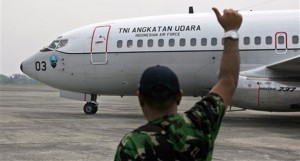Why do airplane transponders have an ‘off switch?’

A ground crew gives an ‘OK’ sign to the pilots of an Indonesian Air Force Boeing 737 “Surveiller” of the 5th Air Squadron “Black Mermaids” as they prepare to take off for a search operation for the missing Malaysia Airlines jetliner MH370, at Suwondo Air base in Medan, North Sumatra, Indonesia, Saturday, March 15, 2014. AP
WASHINGTON — Ever since Malaysia Airlines Flight 370 disappeared, a fascinated public has asked: Why can somebody in the cockpit shut of the transponder?
It turns out there are several legitimate reasons why a pilot might want to shut off this key form of communication that allows air traffic controllers to identify and track airplanes.
Authorities believe that Flight 370’s transponder was intentionally shut off, delaying search and rescue efforts and helping to conceal the plane’s location — a mystery unsolved more than 10 days after the Boeing 777 vanished.
It’s rare for a pilot to turn off a transponder during flight, but occasionally there is cause.
- Sometimes a transponder malfunctions, giving out incorrect readings.
- The device could have an electrical short or catch on fire. Pilots would want to shut it down rather than risk a fire spreading to the rest of the cockpit or airplane.
- Pilots used to routinely turn off transponders on the ground at airports so as not to overwhelm air traffic controllers with so many signals in one location. That is increasingly less the case as pilots now use “moving map” displays that take the transponder data and show them the location of other planes on the ground, helping guide them around airports without mishaps.
“As long as there are pilots, they’ll be able to switch off systems,” said Andrew Thomas, editor-in-chief of the Journal of Transportation Security.
Airplanes have two transponders. There are two knobs in the cockpit — one on the right, the other on the left — that control one or the other. When one transponder is on, the other is normally in standby mode.
To turn off a transponder, a pilot turns a knob with multiple positions and selects the “off” setting. The second transponder doesn’t automatically activate if the first one is shut down — a knob would also have to be turned. In this case, it appears one transponder was turned off, and the second not activated.
Ross Aimer, a retired United Airlines pilot and former 777 instructor, said it is possible that one pilot could reach up and turn off the transponder without the other pilot seeing it, say if one was looking away or distracted.
If the plane was in contact with an air traffic controller, the controller would alert the pilots that the transponder signal had been lost. But, Aimer — now head of Aero Consulting Experts — said, if they were not in contact with an air traffic controller, a pilot might miss it if the other shut down the transponder.
In the case of the missing Malaysian plane, even pilots are a bit puzzled by somebody turning off the transponder.
John Gadzinski, a Boeing 737 captain, said that among fellow pilots “there is a raised eyebrow like Spock on ‘Star Trek’ — you just sit there and go, ‘why would anybody do that?'”
RELATED STORIES
Secretive Beijing demands transparency over missing jet